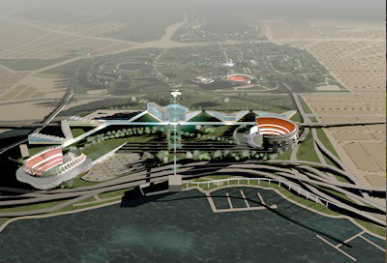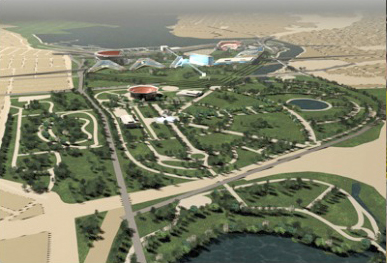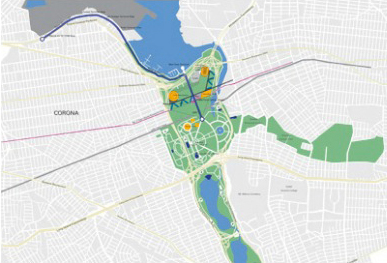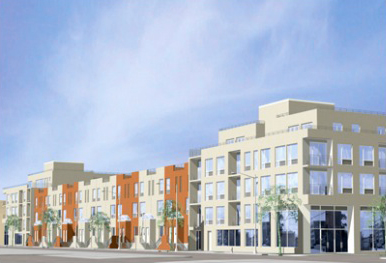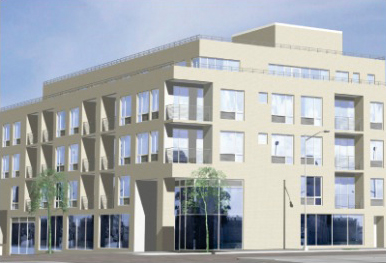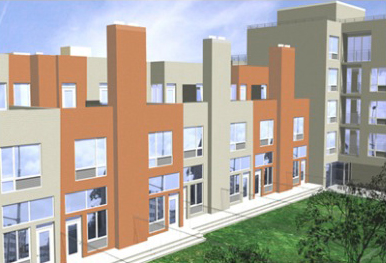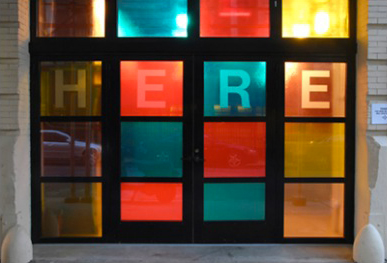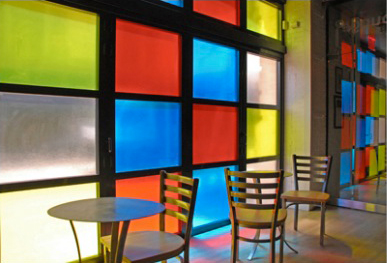
East Midtown Zoning: A Plan Half Done
 By Charles Lauster August 2013
By Charles Lauster August 2013
The City Planning Commission proposal to reinvigorate east midtown’s aging commercial real estate is only half of a potentially effective plan. It solves for the creation of more modern office space where there is little existing developable space available but it does little to ensure that the space will be successful. There is no urbanity in this scheme. From Gramercy Park to Central Park to the Highline, thriving real estate development has combined increased density with public amenity. The second half of the plan has to answer the question of what can be done in an area of Manhattan uniquely lacking in such amenities to make a serious increase in commercial density tolerable?
 First some background. The East Midtown Rezoning recognizes that much of the office space east of Madison Avenue, south of the 57th Street and north of 39th street is over 70 years old and unsuitable for modern Class A use. For instance, the ceilings are too low (think ducts, lighting and cabling) and there are too many columns for open plan offices and flexibility. The Commission proposes that owners of lots over 25,000 square feet be permitted to buy from the city additional build-able square footage that substantially exceeds the current zoning limit. In other words, owners of older, large buildings would be allowed to tear them down and build much taller buildings that meet modern needs.
First some background. The East Midtown Rezoning recognizes that much of the office space east of Madison Avenue, south of the 57th Street and north of 39th street is over 70 years old and unsuitable for modern Class A use. For instance, the ceilings are too low (think ducts, lighting and cabling) and there are too many columns for open plan offices and flexibility. The Commission proposes that owners of lots over 25,000 square feet be permitted to buy from the city additional build-able square footage that substantially exceeds the current zoning limit. In other words, owners of older, large buildings would be allowed to tear them down and build much taller buildings that meet modern needs.
Needless to say the idea is meeting a lot of resistance. Many say there is too much density already and the area’s infrastructure is inadequate. Let’s examine those charges. Pedestrian counts on the east and west sides of midtown are similar and among the highest in Manhattan. Times Square over on the west side, however, has the highest counts in the city. It is certainly true that the 4,5, and 6 subway lines are packed but the Second Avenue line will open in the next few years. Opponents also complain of lost light and air. That complaint is harder to justify; the potential sites for taller buildings in the district are already occupied by tall buildings. No existing open space will be lost because East Midtown does not really have any public open space. The median strip in Park Avenue is about the best the district has to offer. That is the problem. In midtown east of 5th Avenue there are no major parks, no major squares, nothing to interrupt the march of the grid. While it has many fine buildings, its urban fabric is featureless. One finds it hard to form a mental map of the east side because of the spatial uniformity of the district.
The similarly dense Midtown West is full of memorable open spaces. There is Bryant Park to the south and Central Park to the north. Times Square and Rockefeller Center are at the center. Finally, Broadway blows off the grid altogether. All these interventions into the grid create mental markers that provide locations with identities. Much as Kevin Lynch, a revered urban planner at M.I.T., described the elements in the mental maps people form of their surroundings, Midtown West provides a lively “language of city patterns.” Midtown East is comparatively mute.
Midtown East does have one great public space but it is indoors — Grand Central Terminal. Interestingly, the Planning Commission proposal sets its focus for higher structures around the fabled station. In many ways this makes sense. It is a transit hub and 42nd Street is the most used east/west corridor in midtown. If any place can handle increased density it is the area around Grand Central. Unfortunately there is a problem with this location. The MetLife Building, even without increased building height around it, is a black hole of urban energy. It interrupts the grid not as an enlivening, Lynchian marker but more like an overturned bus. At the sidewalk level it is an obstacle course with heavy security.
The point is not whether MetLife is an attractive building. It is in the wrong place if the buildings immediately around it are to be greatly increased in size. One of the magical aspects of the grid is its capacity to accommodate many very large buildings without overpowering the cityscape. Consider the contrast between the Financial District and midtown in terms of physical and visual movement. Compared to the dim maze downtown, the uptown grid promotes spatial orientation and more light to the street. That movement stops at the MetLife Building. By being off the grid it crowds and blocks people, space and light. Its off-grid stance amid a cluster of new, tall, on-grid buildings will create an anomaly in midtown — downtown type canyons. Narrow Vanderbilt Avenue will become Exchange Place.
A step to answering this problem would be to take down the MetLife Building and replace it with a park between the old New York Central Building and what is left of Grand Central. Park Avenue, which never had a park, would finally have one, the ramps around the station defining it. The new, substantially taller buildings around Grand Central would occupy their customary places in the Manhattan grid more comfortably. The vista along 44th Street would be open east/west and the New York Central Building would regain its majesty on Park Avenue. The public open space gained by removing the MetLife Building, would begin to offset the perceived burden of more building bulk in the neighborhood. That, in fact, would be the deal: more open public space on the ground for more commercial space in the sky. The revenue from the sale of increased square footage could be dedicated to the purchase of parkland.
Taking down a building of this size, 58 stores in over 800 feet, is well within the capabilities on the New York construction industry. An objection might be that we would be taking down a Class A building when we are trying to increase the amount of Class A space. But is MetLife really Class A? Some very old space is Class A. 30 Rockefeller Plaza, for instance, is 80 years old but with the very best cachet. The MetLife Building is 50 years old, an awkward age. While it is superbly sited for access to Grand Central (after all it landed on top of it) there is nothing up-to-date in its spaces, systems or functional options. It is merely a well-maintained, older building attached to a world famous train station.
MetLife has 3,077,671 square feet. The Commission’s proposal is to replace 10 million square feet of out-of-date space and add another 4.5 million additional square feet. In total they are proposing 14.5 million square feet in new construction. Turning MetLife into a park would reduce the district’s office space of all sorts slightly but not reduce the new space at all. If the loss of 3 million square feet of fifty year old space is a problem, the eastern border of East Midtown, which moves between Second and Third Avenues, could be tweaked to pick up a few more sites or the new buildings could go higher.
To complete its plan for more modern commercial space in east midtown, the city should provide a level of urbanity, of memorable public space, to offset the increased density. The revenue from the sale of building rights will be inadequate for a subway or most serious infrastructure but it might go a long way with parks. East Midtown, in any case, should be in better balance with West Midtown in terms of parks. It will be competing with Hudson Yards for tenants and that district will have a variety of outdoor spaces and the Hudson River, Lynchian markers galore. If the city wants to increase the density around Grand Central, it needs a similar level of urban amenity. The equivalent of a Highline but lower, a park on the roof of a railroad, a park on Park Avenue.
![]() A challenge facing Bill de Blasio is how to best to make a major impact on providing affordable housing with the city’s meager funding options. One possible route would be to rebuild the New York City Housing Authority into the greatest public housing agency in the country. It was great once. In a nation that is increasingly turning its back on public housing, it could be again. No matter what city housing policy he chooses, the city will have to fund the maintenance of its public housing stock. It can do this in the lackadaisical manner of the past decade or it can make its public housing a model to be followed by building owners throughout the city.
A challenge facing Bill de Blasio is how to best to make a major impact on providing affordable housing with the city’s meager funding options. One possible route would be to rebuild the New York City Housing Authority into the greatest public housing agency in the country. It was great once. In a nation that is increasingly turning its back on public housing, it could be again. No matter what city housing policy he chooses, the city will have to fund the maintenance of its public housing stock. It can do this in the lackadaisical manner of the past decade or it can make its public housing a model to be followed by building owners throughout the city. organization, NYCHA been has allowed to drift into dysfunction. Repairs have not been made to apartments. Purchasing has been uncoordinated. Building modernization has not gone well. The leadership has been more focused on financial deals than on running the operation. The residents are in near rebellion over their perception of being ignored. The new commissioner, Shola Olatoye, will have her hands full. If, however, she is recognized as leading a major strategy for rebuilding affordable housing in New York, her hand to reorganize and reform NYCHA would be immeasurably strengthened. She will need serious mayoral backing to reshape the NYCHA bureaucracy into an operation capable getting its money’s worth from the funding that it has. If she succeeds, it will be a triumph in itself.
organization, NYCHA been has allowed to drift into dysfunction. Repairs have not been made to apartments. Purchasing has been uncoordinated. Building modernization has not gone well. The leadership has been more focused on financial deals than on running the operation. The residents are in near rebellion over their perception of being ignored. The new commissioner, Shola Olatoye, will have her hands full. If, however, she is recognized as leading a major strategy for rebuilding affordable housing in New York, her hand to reorganize and reform NYCHA would be immeasurably strengthened. She will need serious mayoral backing to reshape the NYCHA bureaucracy into an operation capable getting its money’s worth from the funding that it has. If she succeeds, it will be a triumph in itself.

 Then there is the issue of active play. While a good portion of the day is taken up with teaching, kids need to burn off energy in play. This is the biggest problem in New York City facilities. Real play requires real space. Space to run, jump and climb on things. The classrooms are full of instructional items; vigorous play in there is asking for trouble. Yet a nice, big space could be another classroom serving yet more children. Since the financial feasibility of a center is tied to the number of kids served, classrooms almost always take precedence over indoor play space. Outdoor play space, the best solution for active exercise, is very difficult find. Moving the children to a playground or park near the center is a complex undertaking. Try getting thirty three year olds out of the building, across the street and down the block to a park; it is a big deal. To make matters worse, many of the spaces in New York that might work as a center are no where near outdoor space appropriate for young children. Some buildings have roof space that can be made into successful play grounds but again the cost is significant.
Then there is the issue of active play. While a good portion of the day is taken up with teaching, kids need to burn off energy in play. This is the biggest problem in New York City facilities. Real play requires real space. Space to run, jump and climb on things. The classrooms are full of instructional items; vigorous play in there is asking for trouble. Yet a nice, big space could be another classroom serving yet more children. Since the financial feasibility of a center is tied to the number of kids served, classrooms almost always take precedence over indoor play space. Outdoor play space, the best solution for active exercise, is very difficult find. Moving the children to a playground or park near the center is a complex undertaking. Try getting thirty three year olds out of the building, across the street and down the block to a park; it is a big deal. To make matters worse, many of the spaces in New York that might work as a center are no where near outdoor space appropriate for young children. Some buildings have roof space that can be made into successful play grounds but again the cost is significant. First some background. The East Midtown Rezoning recognizes that much of the office space east of Madison Avenue, south of the 57th Street and north of 39th street is over 70 years old and unsuitable for modern Class A use. For instance, the ceilings are too low (think ducts, lighting and cabling) and there are too many columns for open plan offices and flexibility. The Commission proposes that owners of lots over 25,000 square feet be permitted to buy from the city additional build-able square footage that substantially exceeds the current zoning limit. In other words, owners of older, large buildings would be allowed to tear them down and build much taller buildings that meet modern needs.
First some background. The East Midtown Rezoning recognizes that much of the office space east of Madison Avenue, south of the 57th Street and north of 39th street is over 70 years old and unsuitable for modern Class A use. For instance, the ceilings are too low (think ducts, lighting and cabling) and there are too many columns for open plan offices and flexibility. The Commission proposes that owners of lots over 25,000 square feet be permitted to buy from the city additional build-able square footage that substantially exceeds the current zoning limit. In other words, owners of older, large buildings would be allowed to tear them down and build much taller buildings that meet modern needs.
